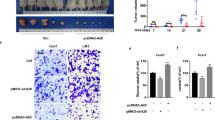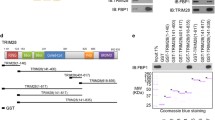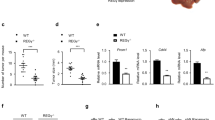Abstract
Hepatocellular carcinoma (HCC) is one of the most common malignancies with high morbidity and mortality. Beta-1,3-galactosyltransferase 5 (b3galt5) plays crucial roles in protein glycosylation, but its function in HCC remains unclear. Here, we investigated the role and underlying mechanism of b3galt5 in HCC. We found that b3galt5 is highly expressed and associated with a poor prognosis in HCC patients. In vitro studies showed that b3galt5 promoted the proliferation and survival of HCC cells. We also demonstrated that b3galt5 deficiency suppressed hepatocarcinogenesis in DEN/TCPOBOP-induced HCC. Further investigation confirmed that b3galt5 promoted aerobic glycolysis in HCC. Mechanistically, b3galt5 promoted glycolysis by activating the mTOR/p70s6k pathway through O-linked glycosylation modification on mTOR. Moreover, p70s6k inhibition reduced the expression of key glycolytic enzymes and the glycolysis rate in b3galt5-overexpressing cells. Our study uncovers a novel mechanism by which b3galt5 mediates glycolysis in HCC and highlights the b3galt5-mTOR/p70s6k axis as a potential target for HCC therapy.








Similar content being viewed by others
Availability of data and materials
All data generated during this study are included in this published article and its supplementary files.
References
Bennett EP, Mandel U, Clausen H, Gerken TA, Fritz TA, Tabak LA (2012) Control of mucin-type O-glycosylation: a classification of the polypeptide GalNAc-transferase gene family. Glycobiology 22(6):736–756
Cherepanova N, Shrimal S, Gilmore R (2016) N-linked glycosylation and homeostasis of the endoplasmic reticulum. Curr Opin Cell Biol 41:57–65
Zhang S, Cao X, Gao Q, Liu Y (2017) Protein glycosylation in viral hepatitis-related HCC: characterization of heterogeneity, biological roles, and clinical implications. Cancer Lett 406:64–70
Chikhaliwala P, Rai R, Chandra S (2019) Simultaneous voltammetric immunodetection of alpha-fetoprotein and glypican-3 using a glassy carbon electrode modified with magnetite-conjugated dendrimers. Mikrochim Acta 186:255
Eichler J (2019) Protein glycosylation. Curr Biol. 29(7):229–231
Salvini R, Bardoni A, Valli M, Trinchera M (2001) beta 1,3-galactosyltransferase beta 3Gal-T5 acts on the GlcNAcbeta 1–>3Galbeta 1–>4GlcNAcbeta 1–>R sugar chains of carcinoembryonic antigen and other N-linked glycoproteins and is down-regulated in colon adenocarcinomas. J Biol Chem 276:3564–3573
Zhou D, Berger EG, Hennet T (1999) Molecular cloning of a human UDP-galactose:GlcNAcbeta1,3GalNAc beta1, 3 galactosyltransferase gene encoding an O-linked core3-elongation enzyme. Eur J Biochem 263:571–576
Liao YM, Wang YH, Hung JT et al (2021) High B3GALT5 expression confers poor clinical outcome and contributes to tumor progression and metastasis in breast cancer. Breast Cancer Res 23:5
Chuang PK, Hsiao M, Hsu TL et al (2019) Signaling pathway of globo-series glycosphingolipids and β1,3-galactosyltransferase V (β3GalT5) in breast cancer. Proc Natl Acad Sci U S A 116(9):3518–3523
Engle DD, Tiriac H, Rivera KD et al (2019) The glycan CA19-9 promotes pancreatitis and pancreatic cancer in mice. Science 364(6446):1156–1162
Seko A, Kataoka F, Aoki D et al (2009) Beta 1,3-galactosyltransferases-4/5 are novel tumor markers for gynecological cancers. Tumour Biol 30:43–50
Estes C, Anstee QM, Arias-Loste MT et al (2018) Modeling NAFLD disease burden in China, France, Germany, Italy, Japan, Spain, United Kingdom, and United States for the period 2016–2030. J Hepatol 69(4):896–904
Beyoğlu D, Imbeaud S, Maurhofer O et al (2013) Tissue metabolomics of hepatocellular carcinoma: tumor energy metabolism and the role of transcriptomic classification. Hepatology 58:229–238
Ma R, Zhang W, Tang K et al (2013) Switch of glycolysis to gluconeogenesis by dexamethasone for treatment of hepatocarcinoma. Nat Commun 4:2508
Kowalik MA, Guzzo G, Morandi A et al (2016) Metabolic reprogramming identifies the most aggressive lesions at early phases of hepatic carcinogenesis. Oncotarget 7(22):32375–32393
Ling S, Shan Q, Zhan Q et al (2020) USP22 promotes hypoxia-induced hepatocellular carcinoma stemness by a HIF1α/USP22 positive feedback loop upon TP53 inactivation. Gut 69:1322–1334
Weng ML, Chen WK, Chen XY et al (2020) Fasting inhibits aerobic glycolysis and proliferation in colorectal cancer via the Fdft1-mediated AKT/mTOR/HIF1α pathway suppression. Nat Commun 11:1869
Wu H, Pan L, Gao C et al (2019) Quercetin inhibits the proliferation of glycolysis-addicted HCC Cells by reducing hexokinase 2 and Akt-mTOR pathway. Molecules 24:2
Cheng SC, Quintin J, Cramer RA et al (2014) mTOR- and HIF-1α-mediated aerobic glycolysis as metabolic basis for trained immunity. Science 345(6204):1250684
Kuo HH, Lin RJ, Hung JT et al (2017) High expression FUT1 and B3GALT5 is an independent predictor of postoperative recurrence and survival in hepatocellular carcinoma. Sci Rep 7(1):10750
Kang X, Wang N, Pei C et al (2012) Glycan-related gene expression signatures in human metastatic hepatocellular carcinoma cells. Exp Ther Med 3:415–422
Chung TW, Kim SJ, Choi HJ et al (2014) Hepatitis B virus X protein specially regulates the sialyl Lewis a synthesis among glycosylation events for metastasis. Mol Cancer 13:222
Dorsch MA, de Yaniz MG, Fiorani F et al (2019) A descriptive study of lectin histochemistry of the placenta in cattle following inoculation of Neospora caninum. J Comp Pathol 166:45–53. https://doi.org/10.1016/j.jcpa.2018.10.172
Jang JS, Wang X, Vedell PT, Wen J, Zhang J, Ellison DW, Evans JM, Johnson SH, Yang P, Sukov WR et al (2016) Custom gene capture and next-generation sequencing to resolve discordant ALK status by FISH and IHC in lung adenocarcinoma. J Thorac Oncol 11:1891–1900
Balsa E, Soustek MS, Thomas A et al (2019) ER and nutrient stress promote assembly of respiratory chain supercomplexes through the PERK-eIF2α axis. Mol Cell 74:877–90.e6
Saada A, Vogel RO, Hoefs SJ et al (2009) Mutations in NDUFAF3 (C3ORF60), encoding an NDUFAF4 (C6ORF66)-interacting complex I assembly protein, cause fatal neonatal mitochondrial disease. Am J Hum Genet 84:718–727
Bourens M, Barrientos A (2017) A CMC1-knockout reveals translation-independent control of human mitochondrial complex IV biogenesis. EMBO Rep 18:477–494
Van Vranken JG, Bricker DK, Dephoure N et al (2014) SDHAF4 promotes mitochondrial succinate dehydrogenase activity and prevents neurodegeneration. Cell Metab 20:241–252
Iansante V, Choy PM, Fung SW et al (2015) PARP14 promotes the Warburg effect in hepatocellular carcinoma by inhibiting JNK1-dependent PKM2 phosphorylation and activation. Nat Commun 6:7882
Kato T, Wang Y, Yamaguchi K et al (2001) Overexpression of lysosomal-type sialidase leads to suppression of metastasis associated with reversion of malignant phenotype in murine B16 melanoma cells. Int J Cancer 92(6):797–804
Li JV, Ng CA, Cheng D, Zhou Z, Yao M, Guo Y, Yu ZY, Ramaswamy Y, Ju LA, Kuchel PW, Feneley MP, Fatkin D, Cox CD (2021) Modified N-linked glycosylation status predicts trafficking defective human Piezo1 channel mutations. Commun Biol 4:1038. https://doi.org/10.1038/s42003-021-02528-w
Yang S, Onigman P, Wu WW, Sjogren J, Nyhlen H, Shen RF, Cipollo J (2018) Deciphering protein O-glycosylation: solid-phase chemoenzymatic cleavage and enrichment. Anal Chem 90:8261–8269. https://doi.org/10.1021/acs.analchem.8b01834
Yao L, Xuan Y, Zhang H, Yang B, Ma X, Wang T, Meng T, Sun W, Wei H, Ma X et al (2021) Reciprocal REGγ-mTORC1 regulation promotes glycolytic metabolism in hepatocellular carcinoma. Oncogene 40:677–692
Pusapati RV, Daemen A, Wilson C et al (2016) mTORC1-dependent metabolic reprogramming underlies escape from glycolysis addiction in cancer cells. Cancer Cell 29(4):548–562
Spiro RG (2002) Protein glycosylation: nature, distribution, enzymatic formation, and disease implications of glycopeptide bonds. Glycobiology 12:43R-56R
Lee HH, Wang YN, Xia W et al (2019) Removal of N-linked glycosylation enhances PD-L1 detection and predicts anti-PD-1/PD-L1 therapeutic efficacy. Cancer Cell 36:168–78.e4
Huang Y, Zhang HL, Li ZL, Du T, Chen YH, Wang Y, Ni HH, Zhang KM, Mai J, Hu BX, Huang JH, Zhou LH, Yang D, Peng XD, Feng GK, Tang J, Zhu XF, Deng R (2021) FUT8-mediated aberrant N-glycosylation of B7H3 suppresses the immune response in triple-negative breast cancer. Nat Commun 12:2672. https://doi.org/10.1038/s41467-021-22618-x
Kalra AV, Campbell RB (2007) Mucin impedes cytotoxic effect of 5-FU against growth of human pancreatic cancer cells: overcoming cellular barriers for therapeutic gain. Br J Cancer 97:910–918. https://doi.org/10.1038/sj.bjc.6603972
Yin S, Liu L, Gan W (2021) The roles of post-translational modifications on mTOR signaling. Int J Mol Sci 22:2
Pyo KE, Kim CR, Lee M, Kim JS, Kim KI, Baek SH (2018) ULK1 O-GlcN acylation is crucial for activating VPS34 via ATG14L during autophagy initiation. Cell Rep 25:2878-2890.e4. https://doi.org/10.1016/j.celrep.2018.11.042
Ednie AR, Bennett ES (2020) Intracellular O-linked glycosylation directly regulates cardiomyocyte L-type Ca(2+) channel activity and excitation-contraction coupling. Basic Res Cardiol 115:59. https://doi.org/10.1007/s00395-020-00820-0
Wang C, Li Y, Yan S, Wang H, Shao X, Xiao M, Yang B, Qin G, Kong R, Chen R, Zhang N (2020) Interactome analysis reveals that lncRNA HULC promotes aerobic glycolysis through LDHA and PKM2. Nat Commun 11:3162. https://doi.org/10.1038/s41467-020-16966-3
Yao D, Xu L, Xu O, Li R, Chen M, Shen H, Zhu H, Zhang F, Yao D, Chen YF, Oparil S, Zhang Z, Gong K (2018) O-Linked β-N-acetylglucosamine modification of A20 enhances the inhibition of NF-κB (nuclear factor-κB) activation and elicits vascular protection after acute endoluminal arterial injury. Arterioscler Thromb Vasc Biol 38:1309–1320. https://doi.org/10.1161/ATVBAHA.117.310468
Barkeer S, Chugh S, Batra SK, Ponnusamy MP (2018) Glycosylation of cancer stem cells: function in stemness, tumorigenesis, and metastasis. Neoplasia 20:813–825
Sun X, He Z, Guo L et al (2021) ALG3 contributes to stemness and radioresistance through regulating glycosylation of TGF-β receptor II in breast cancer. J Exp Clin Cancer Res 40:149
Che MI, Huang J, Hung JS et al (2014) β1, 4-N-acetylgalactosaminyltransferase III modulates cancer stemness through EGFR signaling pathway in colon cancer cells. Oncotarget 5:3673–3684
Menendez JA (2015) Metabolic control of cancer cell stemness: lessons from iPS cells. Cell Cycle 14:3801–3811
Peng F, Wang JH, Fan WJ et al (2018) Glycolysis gatekeeper PDK1 reprograms breast cancer stem cells under hypoxia. Oncogene 37:1062–1074
Honjo S, Ajani JA, Scott AW et al (2014) Metformin sensitizes chemotherapy by targeting cancer stem cells and the mTOR pathway in esophageal cancer. Int J Oncol 45:567–574
Mohammed A, Janakiram NB, Brewer M et al (2013) Antidiabetic drug metformin prevents progression of pancreatic cancer by targeting in part cancer stem cells and mTOR signaling. Transl Oncol 6:649–659
Zhou J, Wulfkuhle J, Zhang H et al (2007) Activation of the PTEN/mTOR/STAT3 pathway in breast cancer stem-like cells is required for viability and maintenance. Proc Natl Acad Sci U S A 104:16158–16163
Su R, Nan H, Guo H et al (2016) Associations of components of PTEN/AKT/mTOR pathway with cancer stem cell markers and prognostic value of these biomarkers in hepatocellular carcinoma. Hepatol Res 46:1380–1391
Ma J, Kala S, Yung S, Chan TM, Cao Y, Jiang Y, Liu X, Giorgio S, Peng L (2018) Blocking stemness and metastatic properties of ovarian cancer cells by targeting p70s6k with dendrimer nanovector-based siRNA delivery. Mol Ther 26:70–83
Magalhães-Novais S, Bermejo-Millo JC, Loureiro R, Mesquita KA, Domingues MR, Maciel E, Melo T, Baldeiras I, Erickson JR, Holy J et al (2020) Cell quality control mechanisms maintain stemness and differentiation potential of P19 embryonic carcinoma cells. Autophagy 16:313–333
Acknowledgements
We are grateful to Prof. Jinhan He at the Department of Pharmacy, West China Hospital of Sichuan University, for sharing the b3galt5-/- mice.
Funding
This work was supported by the National Natural Science Foundation of China (81972745 and 81703072), the Ten Thousand Plan Youth Talent Support Program of Zhejiang Province (ZJWR0108009), and the Zhejiang Medical Innovative Discipline Construction Project-2016.
Author information
Authors and Affiliations
Contributions
PHM and HWD designed and supervised the project; ZXL, LH, LQ, WHD, LYL, and HYC performed the animal and cell experiments; WHD and ZXL performed the glycosidase experiment, ZRJ analyzed the GEO database; and ZXL, LH, RLL and HWD wrote and edited the manuscript. All of the coauthors reviewed the manuscript.
Corresponding authors
Ethics declarations
Competing interests
The authors declare no conflicts of interest.
Ethics approval and consent to participate
This study was approved by the Ethics Committee of Zhejiang University. All the animal experiments performed in this study were approved by the Institutional Animal Care and Use Committee of Zhejiang University.
Consent for publication
All authors consent this manuscript to be published.
Additional information
Publisher's Note
Springer Nature remains neutral with regard to jurisdictional claims in published maps and institutional affiliations.
Supplementary Information
Below is the link to the electronic supplementary material.
Rights and permissions
Springer Nature or its licensor (e.g. a society or other partner) holds exclusive rights to this article under a publishing agreement with the author(s) or other rightsholder(s); author self-archiving of the accepted manuscript version of this article is solely governed by the terms of such publishing agreement and applicable law.
About this article
Cite this article
Zhang, X., Liu, H., Wang, H. et al. B3galt5 deficiency attenuates hepatocellular carcinoma by suppressing mTOR/p70s6k-mediated glycolysis. Cell. Mol. Life Sci. 80, 8 (2023). https://doi.org/10.1007/s00018-022-04601-x
Received:
Revised:
Accepted:
Published:
DOI: https://doi.org/10.1007/s00018-022-04601-x




